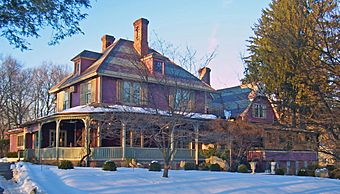Plumbush facts for kids
Quick facts for kids |
|
|
Plumbush
|
|

The front of Plumbush in 2008
|
|
| Location | Cold Spring, NY |
|---|---|
| Nearest city | Beacon, Peekskill |
| Area | 9 acres (4 ha) |
| Built | 1865 |
| Architect | George Edward Harney |
| Architectural style | Gothic Revival |
| MPS | Hudson Highlands MRA |
| NRHP reference No. | 82005386 |
| Added to NRHP | 1982 |
Plumbush is the historic home of Robert Parker Parrott, who was famous for inventing a powerful cannon called the Parrott gun. The house is located near the town of Cold Spring in New York.
The house was built for Parrott in 1865 by a local architect named George Edward Harney. At the time, Parrott was in charge of the nearby West Point Foundry, a factory that made iron products.
Today, Plumbush is on the National Register of Historic Places. This is because of its connection to Parrott and its unique architectural style. The design was inspired by the ideas of Andrew Jackson Downing, a famous designer of homes and landscapes.
Contents
The Plumbush Property
The main Plumbush house is one of four buildings on a 9-acre piece of land. This is what's left of Parrott's original 65-acre farm.
The Main House
The house was designed by George Harney and is made of three main parts. The main section is a two-story block with a special patterned slate roof called a hipped roof. A porch, or veranda, wraps around the south and west sides of the house.
There are also two smaller sections, or wings, attached to the main house. Later, when the house was turned into a restaurant, two more wings were added. They were designed to be hidden so they wouldn't change the original look of the house.
Many of the original windows and decorations are still there. Some new things have been added, like a spiral staircase made of wrought iron. These additions were carefully designed to match the house's historic style.
Other Buildings
There are three other buildings on the property.
- A wood house that was updated by Harney is still considered an important part of the historic site. It has a small tower, called a cupola, on its roof. The inside has been changed so it can be used as a home.
- A carriage house, where horse-drawn carriages were kept, is now used as a garage. It has been changed so much that it no longer looks like it did originally.
- A larger house was built on the back of the property in the mid-1900s.
A Unique Architectural Style
George Harney designed Plumbush in a style called Picturesque. This style was made popular by Andrew Jackson Downing, an important designer who lived nearby. Downing believed that houses in the countryside should blend in with nature.
Before Downing, many houses were built in blocky styles like Federal and Greek Revival. These styles often stood out from the landscape. Downing's idea was to create homes that looked like they belonged in their natural surroundings.
Harney followed Downing's ideas when he designed Plumbush. He placed the veranda next to a group of trees. He also made sure that the Hudson River and the Hudson Highlands could be seen from the upstairs windows.
Downing's Influence
You can see Downing's influence in the house's design.
- The three main parts of the house are not symmetrical, which gives it an interesting, irregular shape.
- The house has different rooflines, a large veranda, and chimneys decorated with medieval-style crosses. These are all features found in Downing's design books.
In 1870, Harney published his own book called Barns, Outbuildings and Fences. It included the original plans and drawings for Plumbush, showing how much he was inspired by Downing's work.
The History of Plumbush
Robert Parker Parrott was an important figure in Cold Spring. He graduated from the nearby United States Military Academy at West Point. During the Civil War, he worked for the Army as an inspector at the West Point Foundry. After the war, the foundry's owner convinced him to leave the army and become the foundry's new manager.
In 1839, Parrott married Mary Kemble, whose uncle had founded the ironworks. They moved into the house that would become known as Plumbush. Parrott lived there until he passed away in 1877.
In 1971, the property was turned into a restaurant. Then, in 2014, the main house and one of the other buildings were renovated. They are now home to The Manitou School, a private elementary school.



